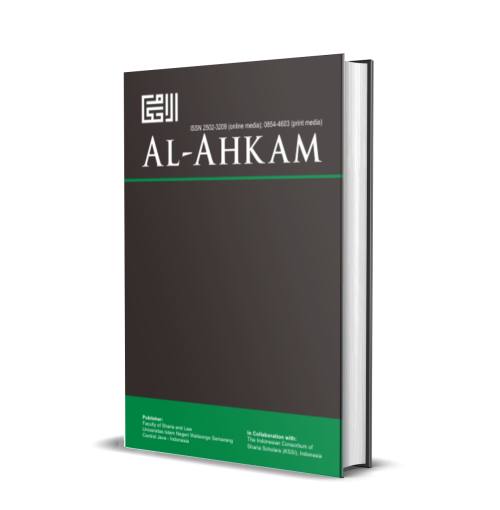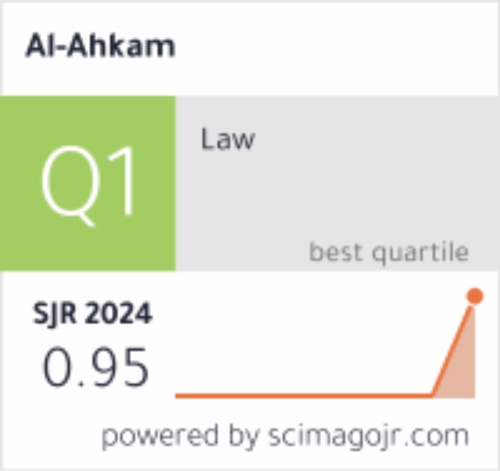
Author Guidelines
The editors invite experts, practitioners, and enthusiasts in Islamic Law and Legal Studies to submit research articles. These should be original, research-based, unpublished, and not under review for possible publication in other journals. All submitted papers are subject to review by the editors, editorial board, and blind reviewers. Submissions that violate our guidelines on formatting or length will be rejected without review.
Online Submission Guidelines
Manuscripts must be sent online to the Al-Ahkam portal.
Steps for Submitting Manuscripts
- Authors should register and check the author column on the registration page.
- After logging in, click "New Submission". The stages of article submission are as follows:
- In the Start section, complete all the checklists, then click Save and Continue.
- In the Upload Submission section, upload the article manuscript file in MS Word format. Then click save and continue.
- In the Enter Metadata section, enter the data of all the authors and affiliates. If there is more than one author, click add author™, then fill in their data in the same way as the first author, and so on. Next, fill in the title, abstract, keywords, research methods, and bibliography in each available column.
- In the Upload Supplementary Files section, uploading supporting files: cover letters, author's contributions statements, or other documents is permissible.
- In the Confirmation section, click Finish Submission if all the data are correct.
General Instructions
- Articles should be formatted according to the writing pattern of scientific journals. The rules in the Publication Manual of the Chicago Manual of Style 17th edition (full note) should be followed. You may use Mendeley or Zotero reference management software and select the setting for the Chicago Manual of Style 17th edition (full note). For an explanation of the Chicago Manual of Style 17th edition (full note) Citation Guide, please see the Chicago Manual of Style 17th edition (full note)
- Articles should be original works, not previously published in any printed or online journal.
- When the submission status (article) is under review or published for this journal, the author(s) will not be allowed to submit the article to another journal.
- Submit the article to the editors online via the Open Journal System (OJS).
- The Cambria font (11 pt), with precisely 15 spacing, should be used in Microsoft Word format with custom size (175,9 x 249,9 mm). The number of words should be written between 6000 and 9000, excluding references.
- Tables or graphs must be in editable format (not screenshots, not Jpeg/png format).
- The article must be written in English. Proofreaders appointed by Al-Ahkam will proofread accepted articles.
Particular Instructions
- The article should result from field research and literature study in Islamic Law and Legal Studies.
- Because of the "Blind Review" system, authors should not include their name, their affiliation, the address of the affiliation, or their email address on the cover of the article. Author™ names, names of institutions, and email addresses are listed at the time of registration on the OJS author page (in the enter metadata section). Please also give us your telephone number when you send your article so we can contact you quickly.
- The content and guidelines of articles should be in narrative essay format, written in paragraphs, with no numbering of headings, and should include these components:
- Title. This should be a brief formulation of the content and be compact and straightforward it may be creative to attract readers. It should be a maximum of 15 words and be in English, in bold format, with the first word of the sentence capitalized.
- Abstract. This should be in English and Indonesian. The abstract should be written in English. It should comprise one single-spaced paragraph and not exceed 200 words. It should be brief and straightforward, comprising four elements: 1) the background and aims of the research, 2) methods, 3) results, and 4) the implication of the research. Do not use abbreviations or citations.
- Keywords. These can be drawn from the research variables, the characteristics of the subjects, and the referenced theories (between 3-5 words or combinations of words, arranged in alphabetical order and separated using semicolons).
- Introduction. The introduction should briefly provide information about the background, literature review, originality of the work, objective, and methods. The background should indicate a knowledge gap that requires answers or explanations. The literature review should provide an exposition of the theories relevant to the research and guide and support understanding and answers to the research question/s. In addition, explain the originality of the work. The objectives should be presented in a narrative using effective sentences. The methods describe the overall research methods used in the research process. It should identify the type of research, data sources, and analysis techniques. The section should be approximately 20% of the total text.
- Theoretical Framework. This section describes the theory used to analyze the data. This section should be approximately 15% of the total text.
- Finding and Discussion. This section should explain the research results to those of previous studies and be critically analyzed and linked to the relevant current literature. The section should give substantial meaning to the analysis results and provide a comparison with the findings of previous studies. This section should also highlight the implications of the findings. The authors should also address the strengths and limitations of their research. This section contains data and analysis results and is approximately 60% of the total text.
- Conclusion. This section presents the main findings of the study. They should be given in concise, clear, and compact sentences based on the results and discussions in the form of paragraphs (not with bullet points or numbering); clarify the findings of the study as a synthesis of the results of the data analysis and discussion; and highlight original findings that contribute to the development of Islamic Law, and Islamic Legal Studies. It should be approximately 5% of the total text.
- Acknowledgment. (if any). This short text acknowledges the contributions of specific colleagues, institutions, or agencies that aided the authors' efforts.
- Authors' Contribution Statement. Please upload in the Uploading Supplementary File section.
- Bibliography. The minimum requirement for bibliographies is 50 references, with 80% sourced from reputable journals. It is recommended that the references be from the last 10 years. Please provide the list of references in alphabetical order and follow the Chicago Manual of Style, 17th edition (full note). All listed references must be cited in the text, and every in-text citation should appear in the reference list. A DOI should be included for each reference, if available. While it is not mandatory, authors are encouraged to use reference management programs such as Mendeley or Zotero.
Tables and Figures
The relationship between the tables or figures and the text should be clear. Authors must explain what the readers should look for when using tables or figures. All tables and picture captions are written with text. The arrangement and placement of tables and figures must refer to the Chicago Manual of Style 17th edition (full note) about tables and figures. Tables and figures must be in the middle of the page, center right and left. Examples of how to display data in tables or figures can be seen on the Article Template.
____________
This author's guidelines have been recently updated (February 2024) and will be available for the forthcoming Volume 34 No 1 (April 2024). Additional provisions exist on the percentage of contents and authors' contribution statements.


